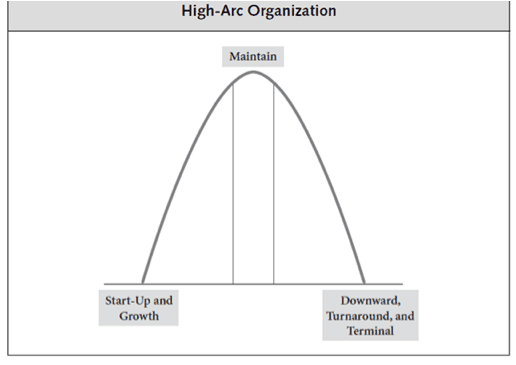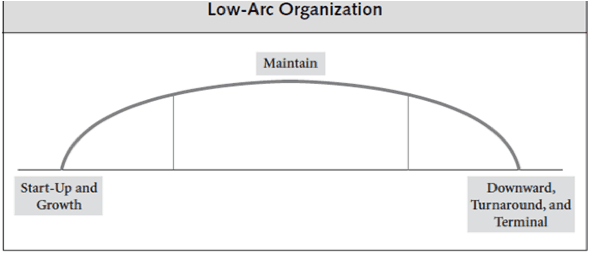In my work with nonprofits, I have noticed a pattern among many organizations: Those with rapid growth trajectories (significant expansion of programs and sites, the number of people they served, operating budget, and so on) often experienced a similarly rapid decline. I came to think of this as “high arc.”

By contrast, “low-arc” organizations—ones more cautious or deliberate in their growth trajectories—tended to decline gradually over a greater period of time. I started to believe that rate of growth can predict a nonprofit’s future, depending on the level of investment and attention it gives to lifecycle development.

In essence, an organization that attempts to do too much, too fast will almost certainly decline as quickly as it grows.
The Growth of High-Arc and Low-Arc Nonprofits
The sector is rife with examples of organizations that have grown for growth’s sake, perhaps convinced that if they don’t grow, they will fail. Or perhaps an organization’s leaders have been more opportunistic than strategic in seizing growth opportunities. It is quite common, for example, for a nonprofit to pursue funding opportunities that do not align well with its mission or specific goals.
Are you enjoying this article? Read more like this, plus SSIR's full archive of content, when you subscribe.
There is no single appropriate rate of growth for a nonprofit. If an organization is too cautious, it may miss important opportunities for funding or collaborative partnerships. If the nonprofit is growing in a reckless or unstructured way, or growing beyond its capacity, growth will most likely be unsustainable. These challenges apply to both programmatic growth and organizational growth. For example, I once worked with a small advocacy organization that received a sizable grant for infrastructure to support its programs. Enhancements included IT upgrades, a bigger office space, and additional staff to focus on development and external communications, and all of these changes were made over a short period of time. Program staff resented the significant infusion of funds into administration, and over time it became clear that the organization lacked the management capacity to integrate these enhancements effectively and to sustain them. This started a spiral of internal dissension that resulted in nearly all staff leaving the organization. The organization never regained its footing, and after two very difficult years, it closed its doors.
Was the high rate of growth this organization’s fundamental problem? Probably not. But the overly rapid and ultimately misguided growth did put pressures on the organization that it could not handle. More measured and strategic growth might have actually helped address the leadership and management challenges. It was on a high-arc trajectory when it should have pursued a low-arc path. The most common trap is growing either in the wrong direction (for example, running mission-inappropriate programs) or too fast (for example, adding programs without paying enough attention to needs related to administration, management, leadership, or operations).
How Understanding Your Arc and Slope Can Aid Strategy
Which scenario best fits your organization?
1. Growing rapidly in a short amount of time
2. Showing signs of moderate growth over a number of years
3. Rapidly declining in a short amount of time
4. Showing signs of moderate decline over a number of years
What does strategy mean if your organization is high-arc or low-arc? If it’s growing or declining? What does program, board, or resource development look like in the context of your organization’s trajectory?
When I was in middle school, I remember learning about the mathematical concept of slope— the ratio of the altitude change to the horizontal distance between any two points. If we apply slope thought to high-arc and low-arc nonprofits, the “altitude change” is the amount of resources gained or lost. The “horizontal distance” is the amount of time over which those resources have been gained or lost.
What is the arc of your organization and how might you change strategies based on this analysis?
Note: Sections of this post have been adapted from Building Nonprofit Capacity.
Support SSIR’s coverage of cross-sector solutions to global challenges.
Help us further the reach of innovative ideas. Donate today.
Read more stories by John Brothers.

